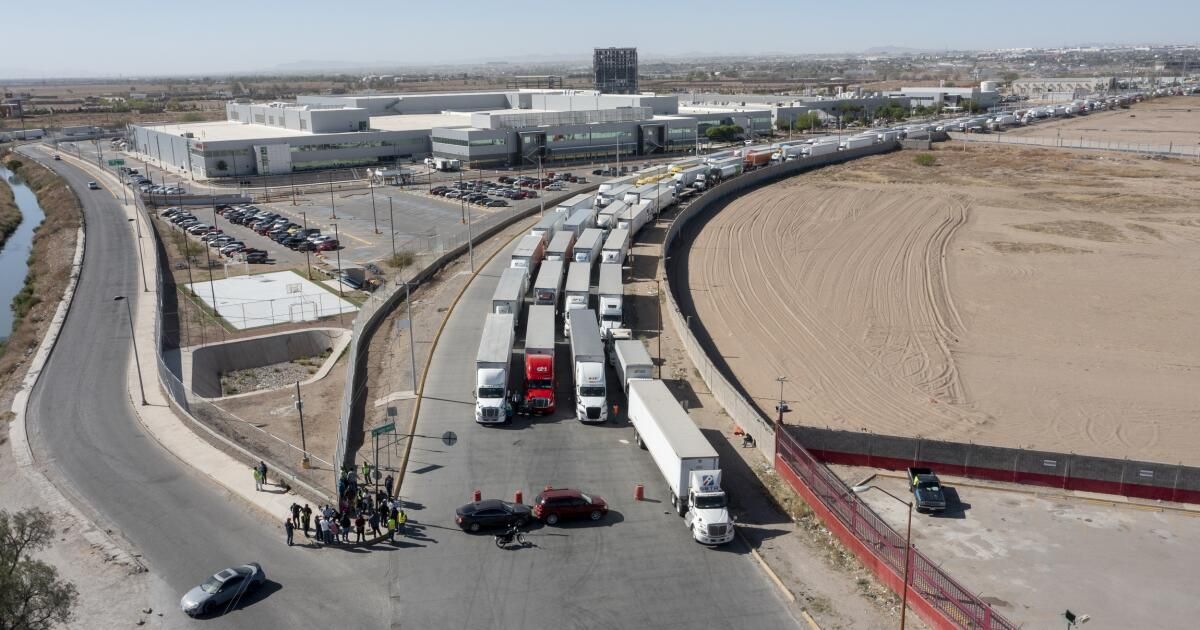As if it weren't worrying enough that higher-skilled, better-paid workers have left California for Texas, evidence shows that the Lone Star State has begun siphoning trade dollars and countless jobs away from Southern ports and hubs. distribution of the Inner Empire.
And the apparent cause of the new turn in the rivalry between Texas and California is not some new policies or programs adopted in Texas to make it a greater magnet for economic activity than was previously located in California. Rather, it is a consequence of the US-China trade war that began when Donald Trump occupied the White House and has continued President Biden's efforts to reduce US dependence on China, especially for high-tech products involving security. national and other issues.
To get around U.S. tariffs and trade restrictions, Chinese companies have dramatically increased investments in Mexico and transported goods to the United States by truck instead of shipping them by sea through the South's huge port and distribution systems. Of California.
The ports of Los Angeles and Long Beach are the busiest in the country, handling about 40% of all maritime cargo from Asia. But last year, the number of 20-foot equivalent containers from China entering the San Pedro port complex fell a combined 12.5% from 2022, to the lowest level in at least a decade, according to S&P Global Market data. Intelligence.
“If we do less business, it simply means fewer jobs,” said Gene Seroka, executive director of the Port of Los Angeles. He said every four containers translates into one job. “Economically, where we all spend our money, if we don't have this burden, it will be less and decisions will have to be made.”
China's share of all containers entering the Port of Los Angeles remains dominant, at 53% last year, although it is down from 57% in 2022. Seroka projects that percentage will fall to the mid-40s in the coming years.
The volume of cargo from the South, in general, has increased significantly in recent months, thanks to the end of negotiations on labor contracts and diversions to the west coast due to the military conflict and the drought that disrupts the Suez and Panama canals, respectively.
But in the long term, Seroka says the decline in incoming Chinese containers will have to be offset elsewhere. In addition to some 15,000 longshoremen, the two ports support hundreds of thousands of jobs in the region: in trucking, warehousing, trade finance and countless small businesses.
California's strict environmental regulations and high business costs add to the pressure.
Undoubtedly, the increase in Mexican imports also benefits Southern California, which has historically received a large volume of land trade, particularly electronics that reach the San Diego border. But the biggest entry point for Mexican products is Laredo, Texas, just north of the large manufacturing center of Monterrey, Mexico, and then El Paso, near Juárez.
“With more and more products coming from Mexico, Texas is geographically and conveniently located,” said Sung Won Sohn, an economics professor at Loyola Marymount University.
Tom Fullerton, a border business economist at the University of Texas at El Paso, says many things made in Mexico are intermediate components, many of which cross the border up to a dozen times. About 90% is transported by trucks. It's no surprise that employment for truckers in Texas has been increasing steadily, while that in California has stopped abruptly, according to the Bureau of Labor Statistics.
“Increased Chinese investment simply creates more business opportunities for companies in Texas,” Fullerton said.
At the moment, the business economies in both Texas and California face some headwinds, including a slowdown in the U.S. economy as a result of anti-inflation efforts, plus cutbacks by retailers and other shoppers who stockpiled excess merchandise even as American consumers have been shifting their spending away from things. to services, such as travel and entertainment.
“Now that we fill the house with everything, everything we could wear and use for years, they say, 'Let's go to the movies, let's go to the ball game,'” said Jock O'Connell, California trade specialist at Beacon Economics. “American demand for imported goods from anywhere is declining.”
Last year, US imports of all goods from China, by ship and air, fell a whopping 20% from 2022, to $427 billion. The Commerce Department reported Thursday that Chinese imports in January increased slightly from December, but decreased 6% from January of last year.
Meanwhile, U.S. imports from Mexico continued to rise in January compared to a year earlier, widening the lead over China. Mexican imports increased after the worst of the pandemic passed and reached $476 billion last year. It was the first time in more than two decades that Americans bought more goods from Mexico than from China.
Overall, the U.S. trade deficit for all goods and services fell nearly 19% last year, the biggest drop since 2009, as Americans bought less foreign oil and Chinese-made phones, toys and household items. In January, the trade deficit widened to $89 billion as U.S. exports were lower than December and the previous year's figures.
Efforts have been made for years to diversify production outside China, partly as a hedge against political risks and rising labor and trade costs in China. But the move toward Mexico and some other nations accelerated after then-President Trump in 2018 imposed large tariffs on a wide range of Chinese imports.
President Biden has not lifted them and, in some ways, tightened trade restrictions on China even further. The pandemic added to the so-called reshoring or nearshoring push as multinationals, affected by a breakdown in transportation and supply chains, sought to be closer to their markets.
Harry Moser, founder of the Reshoring Initiative to bring manufacturing back to the United States, says changes in the country's trade volume don't tell the whole story. While he called the drop in the U.S. trade deficit with China last year a good thing, Moser questioned whether the United States is really less dependent on China.
What is happening, he argued, is that there is a considerable diversion of trade from China through Mexico. And he fears the situation could get worse, pointing to Chinese company BYD's plans to build an electric vehicle factory in Mexico for export to the United States. Even Tesla, which makes its cars in both Shanghai and Texas, is apparently urging some of its Chinese suppliers to locate in Mexico, he said.
“Now is not the time to celebrate the news from China,” Moser said of the reported drop in Chinese imports to the US.
Apparently there is no reason to celebrate in the South either.
Chinese auto parts companies have been among the most aggressive in increasing investments in Mexico. Thirty-three auto parts suppliers of Chinese origin are now registered in Mexico, and 18 of them exported products worth $1.1 billion to the United States last year, 15% more than in 2022, said Michelle Sagrero, manager of INA communications, the auto parts industry. Association in Mexico. She said more Chinese investments are in the pipeline, although she said it was too early to reveal how many companies.
In general, Chinese foreign direct investment, although it stagnated in the United States, continued to grow in Mexico and exceeded $2.5 billion in 2022, five times more than between 2000 and 2004, according to the ALC-China Network, a nonpartisan network of academics in Mexico and other countries. The count of Chinese investments in 2023 has not yet been published, but “it will be substantially higher,” said Enrique Dussel Peters, coordinator of the Center for Chinese-Mexican Studies at UNAM, a university in Mexico City.
The trade war between the United States and China has certainly played an important role, he said. In his study for a United Nations economic group, Dussel Peters found that in 2021, companies exporting goods from China to the United States paid 18.8% of the value of their shipment in tariffs and transportation costs. Comparable costs for exports originating in Mexico to the United States are 1.05%.
“The difference is substantial, to put it politely,” he said.
Dussel Peters says he hopes more Chinese and foreign companies will invest and establish themselves in Mexico. Mexico has free trade pacts not only with the United States but with a few dozen other countries, and also has its own sizable domestic market. But he noted there is a potential problem. So far, Washington has not been as harsh in pressuring Mexico to follow the United States on trade and investment with China.
“There is always the threat of the United States becoming more serious about enforcing its regulations and restrictions,” Dussel Peters said. “You cannot continue with a trade war and a deep conflict and have an important partner of the United States with a sign that tells the Chinese: 'Welcome to Mexico.'”












